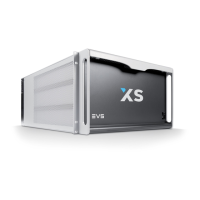Connection Diagram With EVS XHub SDTI Hub
Example of XNet2 network with a SDTI hub:
5.5.3. Required Conditions to Set up and Run XNet
1. All systems on the network must be XT2, XT3 or XS family servers, and XF2,
XStoreSE, XHub2, or XHub3 devices.
2. The SDTI advanced option code (for network client, master, or server modes) must be
validated in the options list.
3. They should all be running compatible software version. A warning message is
displayed when trying to connect an EVS video server with a software version that is
not compatible with the network server.
4. The following parameters must be similar on all systems: SDTI speed (1485Mbps in
Hardware Configuration menu)
5. Network Type must be set to “Server” on one and only one EVS video server on the
network. The others must be set to either “Master” (to share clips and view others
clips) or “Client” (to share clips only).
6. A different network number must be specified for each EVS video server that you
want to connect to the network. If the same network number is assigned to 2 different
systems, the second one will not be able to connect and a warning message will be
displayed.
7. All EVS video servers must be connected with a good quality BNC 75Ohm cable to
form a closed loop. Connect the SDTI OUT connector of the first EVS video server to
the SDTI IN connector of the second one, etc until the loop is closed by connecting
the SDTI OUT connector of the last EVS video server to the SDTI IN connector of the
XS Server-Version 11.00-Hardware Technical Reference Manual
5. Hardware Installation and Cabling 51

